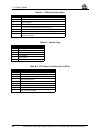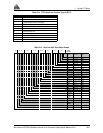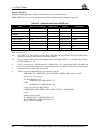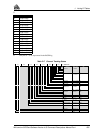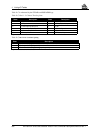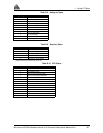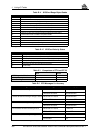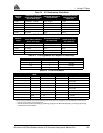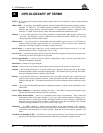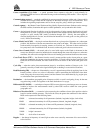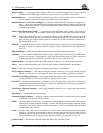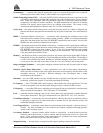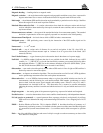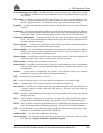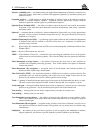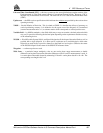
K GPS Glossary of Terms
260 MiLLennium GPSCard Software Version 4.50 Command Descriptions Manual Rev 1
K
GPS Glossary of Terms
ASCII — A 7 bit wide serial code describing numbers, upper and lower case characters, special and non-printing
characters.
Address field — for sentences in the NMEA standard, the fixed length field following the beginning sentence
delimiter "$" (HEX 24). For NMEA approved sentences, composed of a two character talker
identifier and a three character sentence formatter. For proprietary sentences, composed of the
character "P" (HEX 50) followed by a three character manufacturer identification code.
Almanac — a set of orbit parameters that allows calculation of approximate GPS satellite positions and
velocities. The almanac is used by a GPS receiver to determine satellite visibility and as an aid
during acquisition of GPS satellite signals.
Almanac data — a set of data which is downloaded from each satellite over the course of 12.5 minutes. It
contains orbital parameter approximations for all satellites, GPS to universal time conversion
parameters, and single-frequency ionospheric model parameters.
Arrival alarm — an alarm signal issued by a voyage tracking unit which indicates arrival at or at a pre-
determined distance from a waypoint [see arrival circle].
Arrival circle — an artificial boundary placed around the destination waypoint of the present navigation leg,
and entering of which will signal an arrival alarm.
Arrival perpendicular — crossing of the line which is perpendicular to the course line and which passes
through the destination waypoint.
Attenuation — reduction of signal strength
Attitude — the position of an aircraft or spacecraft in relation to a given line or plane, as the horizon.
Azimuth — the horizontal direction of a celestial point from a terrestrial point, expressed as the angular
distance from 000° (reference) clockwise through 360°. The reference point is generally True North,
but may be Magnetic North, or Relative (ship's head).
Bearing — the horizontal direction of one terrestrial point from anther terrestrial point, expressed as the
angular distance from a reference direction, usually measured from 000° at the reference direction
clockwise through 360°. The reference point may be True North, Magnetic North, or Relative (ship's
head).
Carrier — the steady transmitted RF signal whose amplitude, frequency, or phase may be modulated to carry
information.
Carrier Phase Ambiguity (or sometimes ambiguity for short) — the number of integer carrier phase cycles
between the user and the satellite at the start of tracking.
Carrier phase measurements — these are “accumulated delta range” measurements. They contain the
instantaneous phase of the signal (modulo 1 cycle) plus some arbitrary number of integer cycles.
Once the receiver is tracking the satellite, the integer number of cycles correctly accumulates the
change in range seen by the receiver. When a “lock break” occurs, this accumulated value can jump
an arbitrary integer number of cycles (this is called a cycle slip).
Checksum — by NMEA standard, a validity check performed on the data contained in the sentences,
calculated by the talker, appended to the message, then recalculated by the listener for comparison
to determine if the message was received correctly. Required for some sentences, optional for all
others.
Circular Error Probable (CEP) — the radius of a circle, centred at the user’s true location, that contains 50
percent of the individual position measurements made using a particular navigation system.
K GPS GLOSSARY OF TERMS



